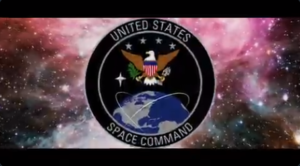President Trump and defense officials formally launched the new and improved U.S. Space Command Aug. 29, lauding the benefits of the 11th warfighting combatant command.
The re-establishment of SPACECOM, which existed from 1985 to 2002 when it was merged with U.S. Strategic Command, was proposed by Vice President Mike Pence in August 2018 as one of several efforts for the U.S. government to place a renewed emphasis on space warfighting (Defense Daily, Aug. 9, 2018).

“it’s going to be a whole different ballgame,” Trump said Thursday in a formal establishment ceremony at the White House. “We will now treat space as an independent region overseen by a new unified geographic combatant command.”
“This is a landmark day, one that recognizes the centrality of space to America’s national security and defense,“ he added.
Trump was flanked by Pence, who also serves as the chair of the National Space Council, as well as Defense Secretary Mark Esper and new U.S. Space Command Commander Air Force Gen. John “Jay” Raymond, who remains dual-hatted as Air Force Space Command commander for one year.
In a Thursday morning media briefing at the Pentagon, Raymond laid out the differences between the previous U.S. Space Command and the newly reestablished Space Command, saying they are designed to respond to specific environments.
“Today’s [command] has a sharper mission focus on protecting and defending our critical space assets,” he told reporters. Those include “a stronger unified structure with our intelligence partners, a strengthened relationship with our allies and a closer connection to our joint warfighting partners and combatant commands.”
He highlighted threats that the U.S. Space Command will work to deter, including reversible jamming of its GPS and communication satellites, directed energy threats and missiles that can be shot from the ground and blow up a satellite.
“We’re concerned about all of those threats. … Primarily the countries that have the more significant threats are China and Russia,” he said.
Raymond noted the “unprecedented alignment” between U.S. government officials on considering space a warfighting domain. Defense officials including U.S. Strategic Command Commander Air Force Gen. John Hyten have previously argued that U.S. Strategic Command cannot adequately prioritize space warfighting as its top mission areas include the nuclear enterprise and nuclear command, control and communications modernization. A new combatant command would give the space domain the attention it demands as peer adversaries boost their own space capabilities, Hyten told Congress this past February (Defense Daily, Feb. 26).
U.S. Space Command’s missions will focus on four specific mission areas, Raymond said.
“The first one is to deter, the second is to defend, the third one is to deliver space combat effects to our joint warfighting partners around the world, and the fourth one is to develop joint warfighters to be able to operate in this contested domain,” he said. “Our goal, our desire is to not have that conflict extend into space.”
The nascent command will assign 287 personnel to its headquarters to start, Raymond said. “That largely is made up of personnel that were currently assigned to the Joint Force Space Component Command [at Vandenberg AFB] and also those that today are part of U.S. Strategic Command that are conducting the space mission,” he said.
“We are currently going through the manpower validation process to determine what the eventual size is, but we’re going to start today with what we have,” he added.
The command will include a headquarters office as well and service components and two operational components: The Combined Force Space Component Command – which will be an elevation of the Joint Force Space Component Command – and a newly formed Joint Space Task Force, he added.
Five current operational centers will also be included in the Space Command: They include the Combined Space Operations Center (CSpOC) at Vandenberg; the National Space Defense Center at Schriever AFB, Colorado; the Missile Warning Center at Cheyenne Mountain Air Force Station, Colorado; the Joint Operations Planning Center at Buckley AFB, Colorado; and the Joint Navigation Warfare Center at Kirtland AFB, New Mexico. “All of those five centers also become part of U.S. Space Command,” Raymond said.
Earlier this month, members of the National Space Council announced that the National Reconnaissance Office (NRO) would partner with U.S. Space Command under the National Space Defense Center, which would help integrate intelligence community and military space capabilities under one roof (Defense Daily, Aug. 20).
Raymond reiterated the new agreement, stating that “in high states of conflict, [the NRO] will respond to the direction of the U.S. Space Command commander as it relates to protecting and defending” U.S. space capabilities.
The new command will not operate the NRO on a day-to-day basis, he clarified, but the agencies “share information, we’re synched, we’re in lockstep together.”
The new command’s budget was $83.8 million in fiscal year 2019, Raymond said. Of that, $75.6 million was shifted from U.S. Strategic Command and consolidated into SPACECOM, he noted.